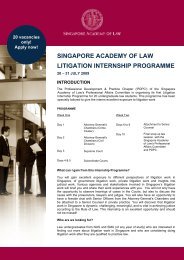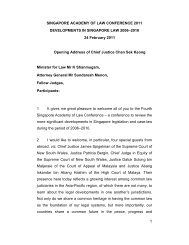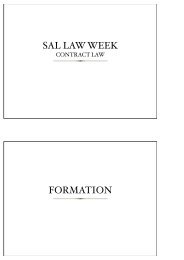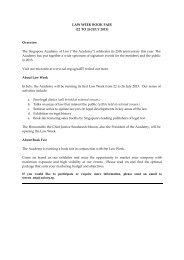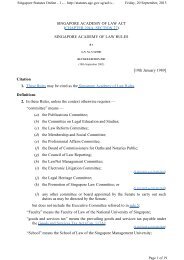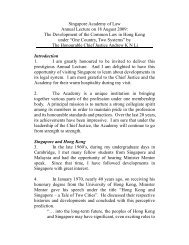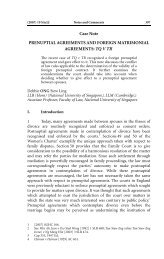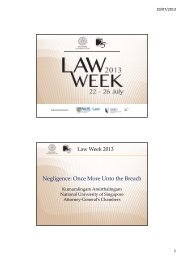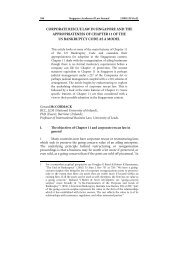2. Managing Mens Rea in Singapore - Singapore Academy of Law
2. Managing Mens Rea in Singapore - Singapore Academy of Law
2. Managing Mens Rea in Singapore - Singapore Academy of Law
You also want an ePaper? Increase the reach of your titles
YUMPU automatically turns print PDFs into web optimized ePapers that Google loves.
348S<strong>in</strong>gapore <strong>Academy</strong> <strong>of</strong> <strong>Law</strong> Journal (2006)punishment <strong>of</strong> a far greater range <strong>of</strong> severity. Clearly a different and moresophisticated approach is needed if the mens rea <strong>of</strong> negligence is to be an<strong>in</strong>creas<strong>in</strong>gly important feature <strong>of</strong> the crim<strong>in</strong>al landscape. Simply tack<strong>in</strong>gon words like “reasonable grounds to believe” after “know<strong>in</strong>g” carrieswith it the danger <strong>of</strong> confus<strong>in</strong>g two dist<strong>in</strong>ct mens rea <strong>of</strong> very differentblameworth<strong>in</strong>ess.63 What does crim<strong>in</strong>al negligence mean? This has proven to be one<strong>of</strong> the most persistent problems <strong>in</strong> the history <strong>of</strong> S<strong>in</strong>gapore crim<strong>in</strong>al law.With the advent <strong>of</strong> the age <strong>of</strong> negligence, the question assumes an evengreater significance. Crim<strong>in</strong>al negligence has received the most judicialattention <strong>in</strong> the context <strong>of</strong> s 304A <strong>of</strong> the Penal Code which conta<strong>in</strong>sabsolutely no explication <strong>of</strong> the concept <strong>of</strong> the negligence which itemploys. This eventually led to the courts <strong>of</strong> British Malaya and theirsuccessor courts squabbl<strong>in</strong>g over its precise mean<strong>in</strong>g for decades. Theyfell <strong>in</strong>to three camps. There were those who could see no reason why theEnglish common law standard <strong>of</strong> “gross negligence” should not apply 103 –the civil law may def<strong>in</strong>e its own negligence for its purposes, but thecrim<strong>in</strong>al law chooses to punish only if negligence atta<strong>in</strong>s a certa<strong>in</strong> degree<strong>of</strong> seriousness. There were those who were set aga<strong>in</strong>st the standard <strong>of</strong>gross negligence, 104 either for reasons <strong>of</strong> autonomy or <strong>of</strong> policy – the PenalCode should not be a slave <strong>of</strong> the English common law, and if thestandard <strong>of</strong> gross negligence were to be imposed, jury convictions mightbe impossible to achieve. Of those who opposed gross negligence, someh<strong>in</strong>ted at some sort <strong>of</strong> <strong>in</strong>termediate standard, 105 while others were <strong>of</strong> the103 Notably, the Federated Malay States decision <strong>of</strong> Cheow Keok v PP [1940] 1 MLJ 103.This decision was subsequently overruled by the Federal Court <strong>of</strong> Malaysia <strong>in</strong> Adnanb<strong>in</strong> Khamis v PP [1972] 1 MLJ 274, now the govern<strong>in</strong>g decision <strong>in</strong> Malaysia, but theFederal Court was unclear as to what was to stand <strong>in</strong> place <strong>of</strong> the test <strong>of</strong> grossnegligence: “mere carelessness or <strong>in</strong>advertence, without anyth<strong>in</strong>g more, is notenough, <strong>in</strong> our op<strong>in</strong>ion, to establish guilt … [but the test to be applied is] whether ornot a reasonable man <strong>in</strong> the same circumstances would have been aware <strong>of</strong> thelikelihood <strong>of</strong> damage or <strong>in</strong>jury to others result<strong>in</strong>g from such conduct”.104 Pr<strong>in</strong>cipally the Court <strong>of</strong> Appeal <strong>of</strong> Sarawak, North Borneo and Brunei <strong>in</strong> PP v Mills[1971] 1 MLJ 4 (“Mills”). The S<strong>in</strong>gapore case <strong>of</strong> Mah Kah Yew v PP [1969–1971]SLR 441 felt itself bound by Mills for reasons <strong>of</strong> stare decisis.105 This was the position <strong>in</strong> Lai T<strong>in</strong> v PP [1939] 1 MLJ 248 (“Lai T<strong>in</strong>”), a Perak decision,and <strong>of</strong> at least Whitton J <strong>in</strong> Woo S<strong>in</strong>g v R [1954] MLJ 200 (“Woo S<strong>in</strong>g”), a S<strong>in</strong>gaporedecision. Murray-Aynsley who had authored Lai T<strong>in</strong> (“I would not go so far as to saythat the degree <strong>of</strong> negligence necessary to support a civil action should be appliedwithout reservation. A crim<strong>in</strong>al charge and a civil action should be approached <strong>in</strong> adifferent spirit”), presided over Woo S<strong>in</strong>g as Chief Justice <strong>of</strong> S<strong>in</strong>gapore and hadbecome rather more enigmatic – he no longer thought it “necessary to lay down adifferent standard <strong>of</strong> negligence <strong>in</strong> civil and crim<strong>in</strong>al cases”.



